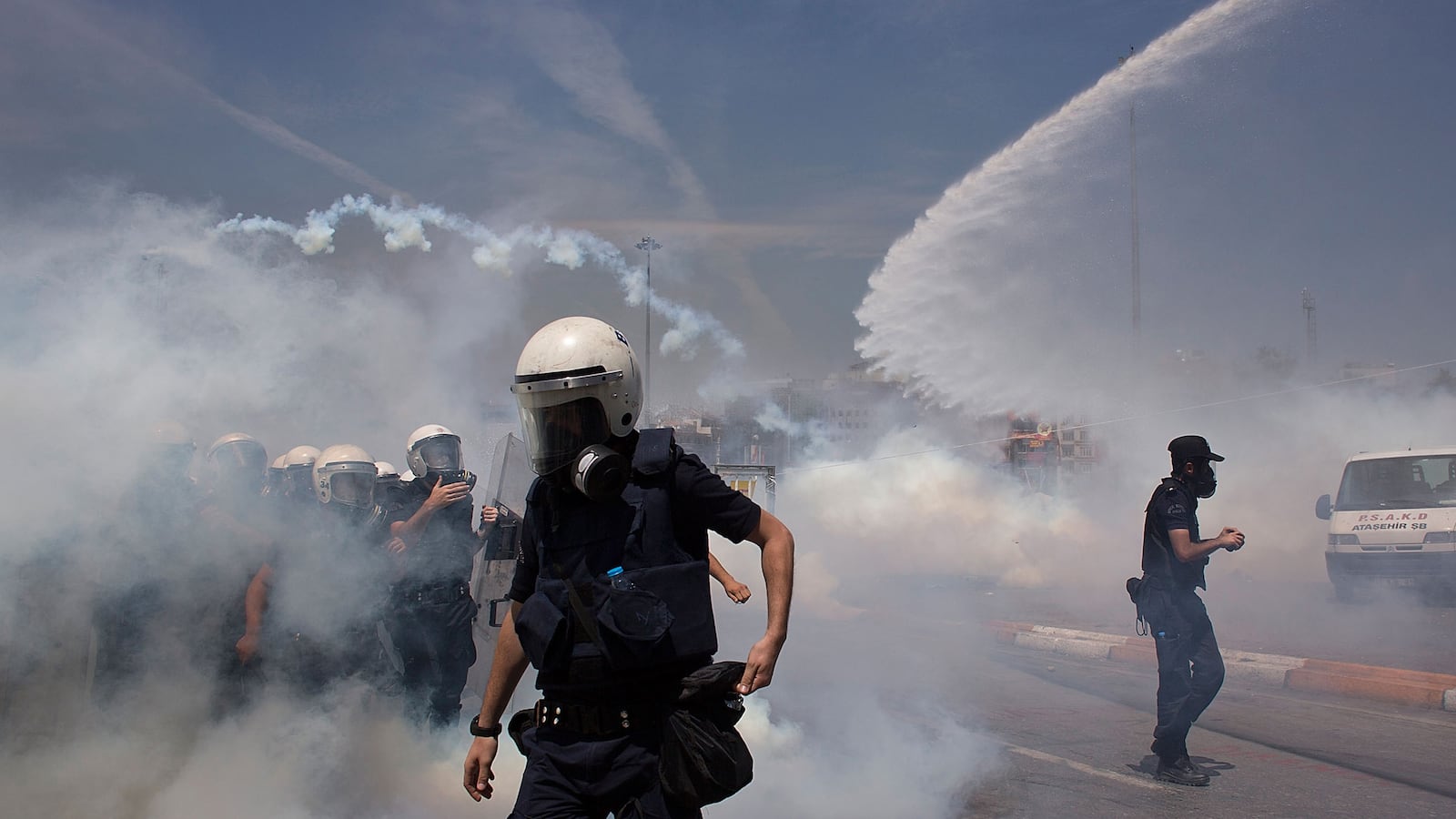Editor's note: This piece has been updated as news is breaking.
For more than a week, protesters had free rein of central Istanbul’s Taksim Square, massing daily in defiance of the government as authorities kept away. Flags and political banners hung from the square’s main monument—a statue of Mustafa Kemal Ataturk, founder of the Turkish republic—and makeshift barricades blocked the surrounding streets. But the tentative peace that had settled over the area came to an abrupt end on Tuesday morning as riot police surged past the barricades and back into the square. Onlookers interrupted their morning commutes to film the chaos on their smartphones as police and protesters resumed their clashes and tear gas once again filled the air.

The hundreds of police who retook the square turned water cannons and tear gas on pockets of demonstrators, some of whom threw rocks and firecrackers, in scenes reminiscent of the clashes that led to the Taksim occupation. As the clashes carried on, teams of clean-up crews wearing surgical masks and orange vests worked quietly to remove the flags and banners from the Ataturk statue and dismantle the barricades. Many of the protesters, meanwhile, retreated to nearby Gezi Park.
The tiny park has become the center of a countrywide push against Prime Minister Recep Tayyip Erdogan. Turkey’s most popular politician, Erdogan has won three straight elections, but protesters accuse him of authoritarianism—and they hold up the park as an example of his heavy-handed style. Despite opposition from residents, authorities had planned to raze the park to make room for a shopping mall, the latest affront in several controversial redevelopment plans that Erdogan is pushing through in Istanbul. Activists staged a small sit-in to save the park in late May, but police cracked down, helping the sit-in to transform into a large-scale push against Erdogan, with like-minded protests spreading across the country. Gezi Park is now home to a large Occupy Wall Street–style encampment.
Police ceded Taksim on June 1, following days of clashes, in an effort to defuse tensions. And other politicians from Erdogan’s Islamic-oriented Justice and Development Party—such as the country’s president and a deputy prime minister—have tried to strike a conciliatory tone. Erdogan, however, has been increasingly defiant. He has derided the protesters as “looters” and “terrorists” and insisted that the park will be razed as planned. He has also suggested that the protests are a “plot” by foreign and domestic agents to destabilize the country. And he has called his own supporters to the streets for rival demonstrations this weekend, which could further inflame the situation.
In what was initially seen as a potential olive branch, the government had previously announced plans for Erdogan to meet with Gezi Park representatives on Wednesday. But some protesters saw Tuesday’s police action as a better indication of his intentions. “They said they were going to negotiate. Is this the way they negotiate?” said one protester, an engineer in Istanbul who gave the nickname Devrim Atli. “The prime minister will try to gather his own supporters. And he will assess his strength. And if he thinks he is strong enough, then he will act accordingly.”
Since taking office in 2003, Erdogan has won accolades for turning around Turkey’s economy and for presiding over a massive expansion of the middle class. He has also steered the country away from its military, which has a long history of coups and political meddling. But Erdogan’s critics charge that he has become authoritarian, concentrating power and forcing through his agenda while the government weakens checks in the media and judiciary. Erdogan has also been accused of imposing religious values on society—shortly before the park protests erupted, the government ordered new restrictions on alcohol that many Turks see as an affront to their secular traditions.
Erdogan has roundly denied the charges of Islamism and authoritarianism. But his combative response to the protests has reinforced the perception among opponents of an increasingly uncompromising leadership style. “He’s doing pretty much everything [he can] to turn this small protest into a major standoff,” says Kerem Oktem, a research fellow at the University of Oxford who writes on modern Turkey. “I don’t think there’s any interest in finding a conciliatory way. He’s closing down a lot of options and slowly bringing himself to a position of complete polarization.”
Erdogan didn't mince words Wednesday. "They say the prime minister is rough. So what was going to happen? Were we going to kneel down in front of these (people)?" he said. "If you call this roughness, I'm sorry, but this Tayyip Erdogan won't change."
Even as Erdogan talked tough on the protests, however, the situation around Taksim threatened to spiral further out of control. Clashes between riot police and hundreds of demonstrators grew consistently uglier as the day wore on. By afternoon, one street beside the park was shook by multiple explosions as parked vehicles caught between the fighting burst into flames, sending black smoke billowing into the air. On the protesters’ side, cries for medics rang out regularly as small teams with stretchers ran to retrieve people who’d been hit with tear gas canisters or overcome by the fumes.
Police also reportedly detained some 50 lawyers Tuesday for protesting at the Istanbul courthouse on behalf of the Gezi Park demonstrations, in a dramatic scene in which some lawyers were dragged from the building.
As in the initial park protests, however, the heavy-handed tactics only seemed to exacerbate the conflict. The crowds continued to swell into the evening, which prompted police to swarm the square in even greater numbers, releasing volley after volley of tear gas and blasting water cannons from crowd control vehicles. The crackdowns sent people fleeing into nearby hotels. In one, staff scrambled frantically to hide the newcomers from the windows, worried their presence might incite police to attack. In the lobby, parents stripped down a weeping toddler who’d been sprayed by the gas, and then washed her eyes and skin with wet paper towels. Outside another hotel in the square, two elderly tourists banged at an iron gate that had been lowered to guard the entrance, pleading through the bars that they were guests. The crowds of demonstrators, meanwhile, simply massed again on nearby streets while demonstrators in gas masks continued throwing their rocks and firecrackers at police.
Istanbul’s governor, Huseyin Avni Mutlu, appealed for calm early on Tuesday, insisting that the police action in Taksim was meant to clear the banners and barricades—and that the protesters in Gezi Park would be allowed to remain. As intense clashes continued around Taksim, the crowds in the park swelled, and protesters massed on its edges to watch. Many protesters distanced themselves from the demonstrators involved in the ongoing clashes—and also insisted that those shown on TV throwing Molotov cocktails were provocateurs sent by police—and suggested that calm could return if the park encampment was left alone. “It all started from Gezi Park,” one 29-year-old filmmaker said. “We still have the park, and we’re not going to leave it.” By Tuesday night, police had not yet entered the park, but were consistently filling it with tear gas, sending the crowds inside choking past the tents.





